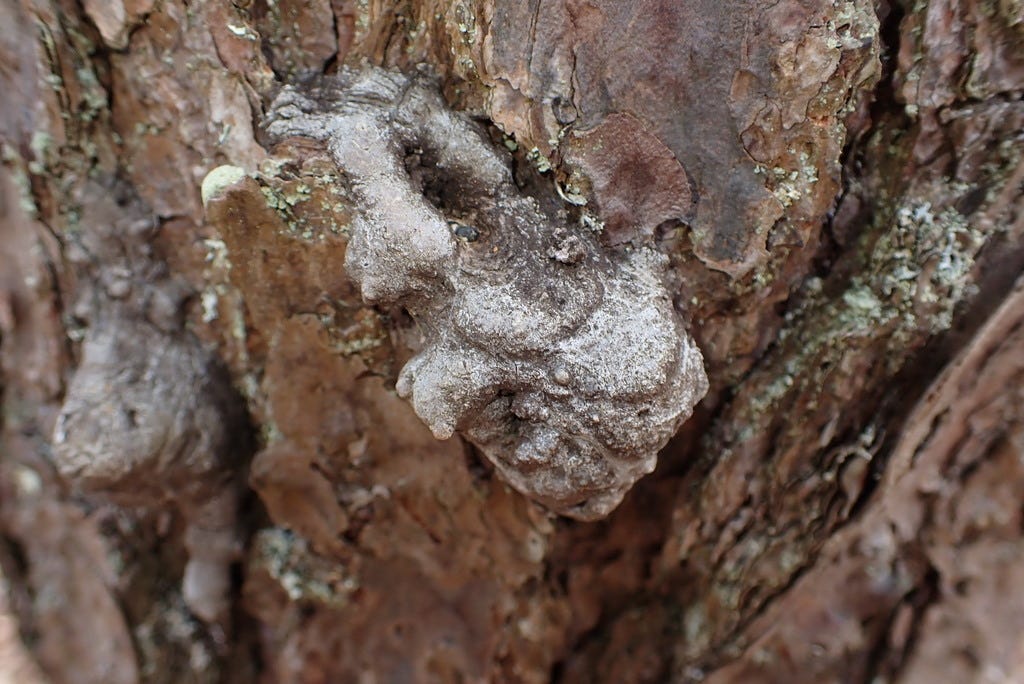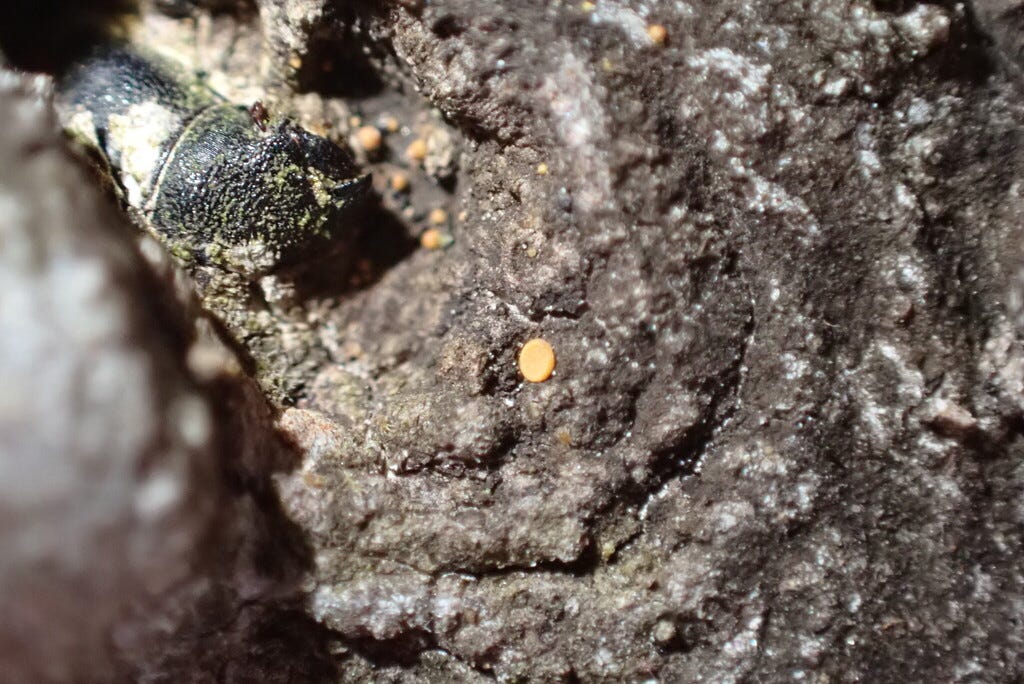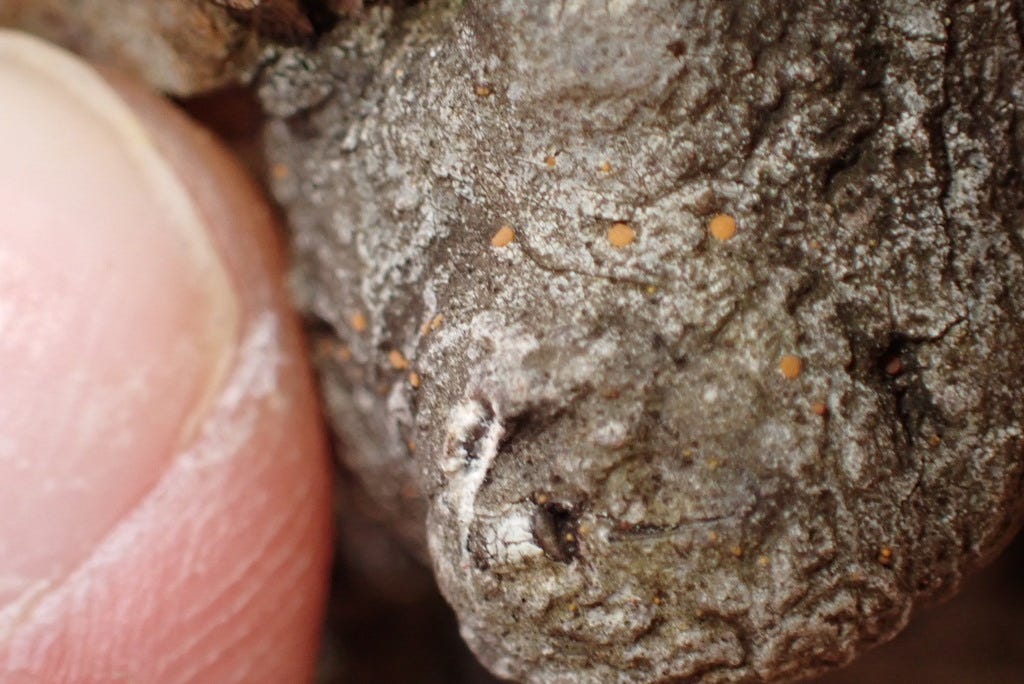Good evening, friends,
Today’s mushroom comes to us from a walk this past week in Harwich, MA with renowned mushroomer Larry Millman. The group discussed the possibility of finding this little disc-like fungus, Zythia resinae, before we went into the woods and we did not go home disappointed. This is a mushroom I originally learned about from the New York Mycological Society, who received a nice feature in the New York Times this past week, and one I’ve been searching for since January.
And you know what, since Earth Day is tomorrow, I may even throw a bonus fungus in at the end. A Toadstool Tuesday Earth Day Two-fer to celebrate.

Fun Facts & Ecology
Z. resinae is a resinicolous fungus which means the fungus grows on the resin produced by plants, in this case the resin from pine trees.
Folks, including myself, tend to use the terms sap, pitch, and resin interchangeably when talking about the sticky substance that oozes out of pine trees. There is, in fact, a difference in the three and it took me way too long to figure out which is what.
There seems to be a misunderstanding online that pine sap is the liquid form of resin, and many blogs perpetuate this idea, but when I consult the “literature” (References 1 & 2) sap and resin are two entirely different liquids with different purposes.
Pine sap is like maple sap; it’s the liquid used to transport nutrients within the pine tree. Unless you’re tapping into the tree’s phloem like you would for maple syrup, the sap stays in the tree.
Pine resin is a liquid produced by specialized resin cells in the tree and is secreted to heal wounds. When a pine tree gets damaged — be it a broken branch or a sap sucker drilling into the tree — the pine produces this anti-bacterial liquid to help cover and heal the wound. The resin has about the same viscosity as honey when initially produced but hardens into a solid when fully congealed. Though it is considered a jewel, amber is actually fossilized resin.

Humans have used pine resin for a variety of different applications across different industries — from a food additive to a furniture varnish to an industrial adhesive. A former middle school upright bass player myself (until I learned the boys’ choir went on more field trips than the orchestra), I would use rosin on my bow which, as the name suggests, is made from tree resin.
In fact, if you heat resin and add a sprinkle of this and a dash of that you create pitch. This pitch can be used as an adhesive, for waterproofing, or as a firestarter. Pitch pines (Pinus rigida) got their common name for their high resin content which allowed for ample pitch production.
The thing is, when you’re in the woods you can say sap, pitch, or resin and it doesn’t really matter. The trees don’t care, the little orange cups growing on the resin don’t care, and none of it interrupts the general goings-on.
The mushroom is almost imperceptibly small, ranging from 0.5 to 1.5 mm, and little is known about how the fungus lives. So little that we’re uncertain where the fungus obtains nutrients — perhaps the mycelium goes inside the tree, perhaps they derive nutrition from the resin itself, or perhaps it’s a different mechanism entirely. The fungus seems to grow in the northern hemisphere wherever pine resin seeps and can be found year-round.
The fungus is the only species in the genus Zythia. The name Zythia comes from the Greek zythos which means “ale” or “beer”. This might refer to the idea that the fungus is fermenting some sugar in the resin, but I couldn’t find an actual explanation. The species epithet resinae was a little easier to decipher, that comes from the Latin word resina which means “resin”.
Bonus Fungus: Pine Needle Split (Lophodermium)

We found this fungus growing on pine needles that had fallen from a pitch pine and we called it Lophodermium pinastri. This was a new species for me. Apparently the fungus lives peacefully inside the pine needle while on the tree and then turns into a decomposer after the tree sheds its needles. However, it is thought that there are parasitic Lophodermium that can cause die-back on the tree, or cause the tree to shed infected needles. When mature, those black scabs split open to reveal the spore-producing layer.
Upcoming
We’ve got Earth Day tomorrow, an event with Wave Hill on Friday, and then it’s down to Gettysburg, PA for Morelfest this weekend.
Enjoy the warm weather and I’ve got a feeling next week we’ll have some fleshier fungi to learn about,
Aubrey
References:
Óscar López-Álvarez, Rafael Zas, Manuel Marey-Perez,
Resin tapping: A review of the main factors modulating pine resin yield,
Industrial Crops and Products, Volume 202, 2023, 117105, ISSN 0926-6690,
https://www.fs.usda.gov/wildflowers/ethnobotany/resins.shtml
Mitchell JK, Garrido-Benavent I, Quijada L, Pfister DH. Sareomycetes: more diverse than meets the eye. IMA Fungus. 2021 Mar 16;12(1):6. doi: 10.1186/s43008-021-00056-0. PMID: 33726866; PMCID: PMC7961326.








Very interesting. Thanks Aubrey.